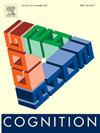Object- and feature-based working memory limits for pairs of complex objects and their development during the school years
IF 2.8
1区 心理学
Q1 PSYCHOLOGY, EXPERIMENTAL
引用次数: 0
Abstract
A key question in the development of working memory is whether children's capacity increases in the number of objects or features. Prior research (Forsberg et al., 2022) indicated that object-based capacity limits predominate, with relatively small improvements in feature retention. However, the procedure in that study included only two features per object, aside from location. In contrast, we tested memory for pairs of four-featured objects with children aged 8–9 years or 10–12 years and young adults (total N = 101). Quantitative modeling of the results showed that feature richness plays a much larger role in working memory development than previously thought. Each object was a stylized arrow with a color, an orientation, an emblem on the arrowhead, and a shape of the stalk of the arrow, an analogy to many real-world objects (e.g., a shirt with a color, current orientation, pocket emblem, and shape of the shirt tail). The analyses separated errors due to attention lapses in which an object was not encoded and errors due to incomplete retention of features within an object. Our findings suggest a two-step model of working memory encoding in which objects are first encoded (with some lapses or unencoded objects), followed by encoding of the multiple features of these objects independently. With these feature-rich stimuli, we showed feature encoding to be a major source of developmental improvement, along with object encoding. These findings challenge prior assumptions and provide new insights into how working memory for realistic, complex objects may develop.
基于对象和特征的工作记忆限制了对复杂对象的记忆及其在上学期间的发展
工作记忆发展的一个关键问题是,儿童的记忆能力是否会随着物体或特征的数量而增加。先前的研究(Forsberg et al., 2022)表明,基于对象的容量限制占主导地位,在特征保留方面的改进相对较小。然而,在该研究中,除了位置之外,每个物体只包含两个特征。相比之下,我们对8-9岁或10-12岁的儿童和年轻人(总N = 101)进行了对四特征物体的记忆测试。定量建模结果表明,特征丰富度在工作记忆发展中的作用比之前认为的要大得多。每个对象都是一个程式化的箭头,带有颜色、方向、箭头上的徽记和箭头柄的形状,这与许多现实世界中的对象(例如,具有颜色、当前方向、口袋徽记和衬衫尾部形状的衬衫)类似。分析分离了由于注意力缺失导致的错误,其中对象没有编码,以及由于对象内的特征保留不完整而导致的错误。我们的研究结果提出了一个两步的工作记忆编码模型,在这个模型中,首先对对象进行编码(包括一些缺失或未编码的对象),然后对这些对象的多个特征进行独立编码。通过这些特征丰富的刺激,我们发现特征编码和对象编码是发育改善的主要来源。这些发现挑战了先前的假设,并为现实、复杂物体的工作记忆如何发展提供了新的见解。
本文章由计算机程序翻译,如有差异,请以英文原文为准。
求助全文
约1分钟内获得全文
求助全文
来源期刊

Cognition
PSYCHOLOGY, EXPERIMENTAL-
CiteScore
6.40
自引率
5.90%
发文量
283
期刊介绍:
Cognition is an international journal that publishes theoretical and experimental papers on the study of the mind. It covers a wide variety of subjects concerning all the different aspects of cognition, ranging from biological and experimental studies to formal analysis. Contributions from the fields of psychology, neuroscience, linguistics, computer science, mathematics, ethology and philosophy are welcome in this journal provided that they have some bearing on the functioning of the mind. In addition, the journal serves as a forum for discussion of social and political aspects of cognitive science.
 求助内容:
求助内容: 应助结果提醒方式:
应助结果提醒方式:


